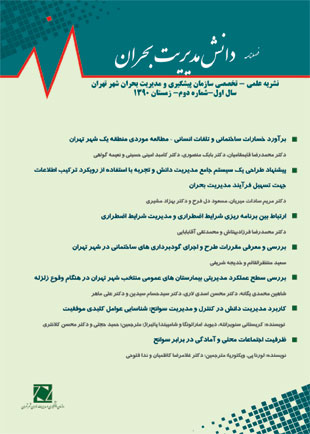فهرست مطالب

فصلنامه دانش پیشگیری و مدیریت بحران
پیاپی 2 (زمستان 1390)
- تاریخ انتشار: 1390/11/18
- تعداد عناوین: 7
- مقاله های فارسی
- ترجمه
-
Page 199The present study estimated the seismic loss due to probable earthquake in Tehran in zone one of Tehran municipality as a case study. To this end, the damage and fatality functions, which were updated based on data from some recent earthquakes such as Bam (2003) and Dahooye-Zarand (2004) earthquakes, were employed. In these functions, the building damage was estimated at three extensive, moderate and slight damage levels. Furthermore, the fatality functions for different building types were estimated at three levels: death, major injury and minor injury. For loss estimation, two north Tehran fault and floating point earthquake scenarios were assumed. Then, the structural damages and human casualties for two north Tehran fault and floating earthquake scenarios were calculated. Based on the results, the rates of killed, heavily injured and wounded population for north Tehran fault and floating point scenarios were found to be 6.2%, 4.6%, 19.3% and 5.3%, 3.9%, 16.3%, respectively.Keywords: Loss estimation Tehran city, Damage, fatality functions, Earthquake disaster management, Tehran
-
Page 215The present paper has suggested the idea of a knowledge-based approach to facilitate disaster management process. Actually, it seems that when a society faces a critical situation, an information system which is built up through collecting and classifying existing knowledge from the various related resources (in an off-line phase) can be very helpful. In case of a disaster (as the online mode of the system), it searches its knowledge base to find the most similar instances to the current situation, and based on the available solution for the original case in the knowledge base, suggests some solutions and preventative warnings to the corresponding human roles, who are involved in the aid provision. As there should be various input sensors available (vision, earthquake intensity detector and even human observers who act as very accurate sensors), one of the main aspects in this system is applying information fusion approaches in all three levels(i. e. data, feature and decision) to recognize the critic situation more precisely. The main purpose of fusion in this paper is the synergic combination of retrieved information from different sensors and mixing these partial perceptions from each modality, so that we can find a certain description of the situation. When the architecture is described in detail, a brief discussion on the structural and functional evaluation of the proposed architecture is presented.Keywords: Knowledge management system, Experience management, Disaster management, Information fusion, Similarity metrics, Damage estimation
-
Page 228Emergency planning is important and complex. The purpose of planning is preparedness of community to face disaster and also reduction of losses, both in terms of human life and in damage to property. The planning process is never complete, because of changes in environmental threat and also changes in the tools of management of threats. The planning process continues to identify new vulnerability. An effective planning process recognizes changes in old vulnerability and also monitors changes in knowledge and technology which affect the ways we respond to emergencies. Through this process, two contexts are very important: • Disaster management that defines the goals, structure, and strategy used to deal with extreme events that can generate losses. • Emergency planning that addresses ways to gather resources and also ways that minimize risk. Through reviewing Hurricane Katrina and California seismic safety, the present article aims at defining the differences between emergencies, disasters and catastrophes as well as describing the relationship between emergency planning and emergency management.Keywords: Emergency planning, Emergency management, Disaster Management
-
Page 244The present article briefly introduces “The regulations for designing and implementing construction excavations” in Tehran. Aspects and levels of activities determined in these regulations are the minimum requirements that Tehran Municipality has stipulated with a general view to ensure the safety of construction excavations. Responsibilities of agents involved in excavation projects, including geotechnical consultants, supervisors, structural engineers and construction managers and the measures needed to reduce risks of excavations are defined and scrutinized in the regulations. These factors and measures are determined based on project characteristics including excavation depth, the soil profile and sensitivity of nearby building(s). The regulation is comprised of a set of technical, administrative and legal requirements for design, construction, supervision and control of work steps in implementing excavation deemed essential for ensuring safety of personnel, pedestrians, residents of nearby buildings and lifelines.Keywords: Construction safety, Building regulations, Excavation, Designing, implementing excavations, Risk assessment, Tehran
-
Page 262IntroductionThe present research project reviews the management work and emergency Response Capacity in seven hospitals in the city of Tehran during an earthquake. The research’s site was general hospitals having private and governmental management. The Research population was all Tehran general hospitals where a disposal sample of seven general hospitals was studied.MethodologyThe study is of descriptive cross- sectional type; sampling was disposal and the instrument for the study was WHO/PAHO Standard check list.FindingsAssessment indicates that incident management system in a hospital in district 4 and a hospital in district 21 were at satisfactory level. The other 5 hospitals were at average level. Only 2 hospitals, one in district 4 and one in district 1 had enough equipment and resources for emergency situation. The other 5 hospitals were at average Level.ConclusionIn conclusion, incident management system and sufficient equipment and resources for emergency situation assessment of the under study hospitals did not show the satisfactory level of ability to respond appropriately at the time of crisis. Our suggestions procedures are as follows: Short term proceeding must be considered to preserve and develop the hospitals’ preparedness for earthquake. The whole medical network must be considered (Private hospitals, medical centers and clinics) during programming. Link of works from incident place to hospital must be considered.Keywords: Hospital emergency management, Hospital management work, Disaster management, Earthquake, Disaster preparedness, Terms of emergency


